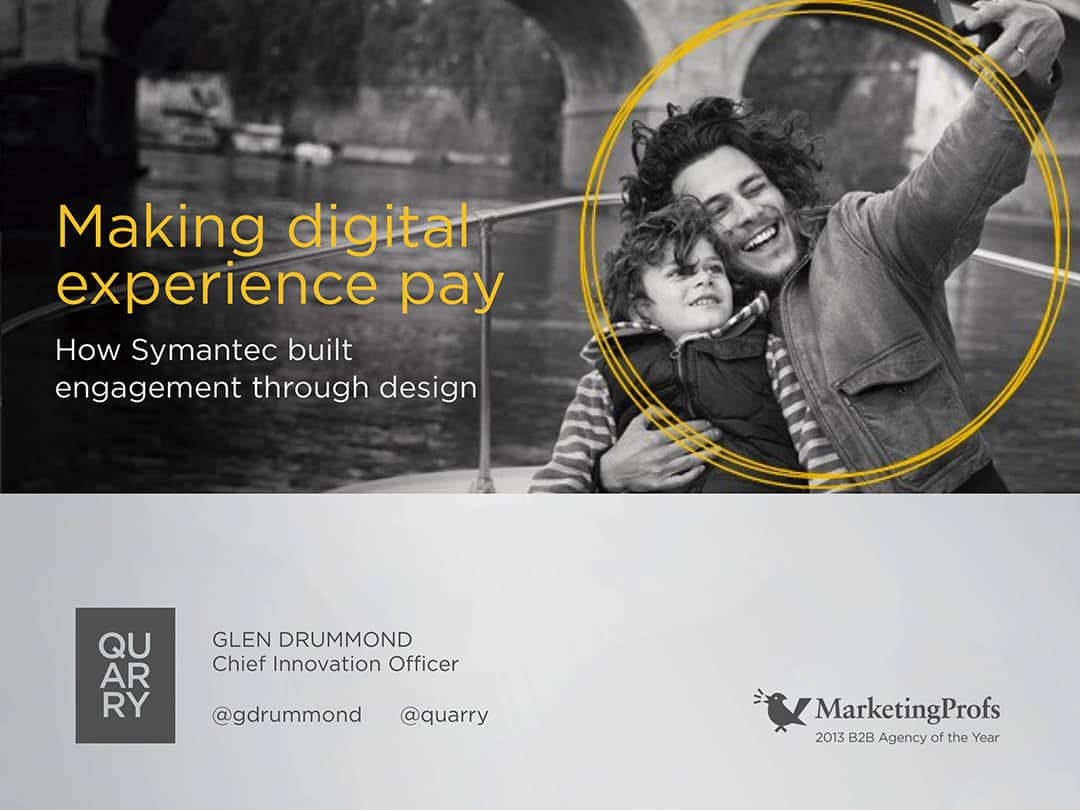
Great modern marketers use “Design Thinking”
Presenting at the 2015 Customer Experience Strategies Summit (#CXCanada) today, Quarry’s Chief Innovation Officer Glen Drummond opened his keynote by discussing the kinds of thinking required to be a great modern marketer. And, in doing so, Glen highlighted both an opportunity and a caution for the assembled group of customer experience (CX) and marketing professionals.
The opportunity: “Design Thinking”
In terms of a simple definition, “Design Thinking” is a creative process based around the “building up” of ideas and, according to Herbert Simon, follows a seven-step process: Define, Research, Ideate, Prototype, Choose, Implement and Learn (for more on Design Thinking, read this Fast Company article). Through this process, Design Thinking offers modern marketers the ideal path for repeatedly creating—and launching—innovative solutions to brand building and customer experience challenges. Moreover, what is important to recognize about Design Thinking is that it blends the best of “validity-based thinking” (that which seeks outcomes that meet the desired objective) and “reliability-based thinking” (that which seeks outcomes that are predictable and consistent) working in combination with one another.
The caution: Relying on a single type
Drummond argued that too much reliance by marketers and CX professionals on just one type of thinking is a recipe for failure. Those who rely too much on “validity-based thinking” are likely to see low levels of traction for new ideas within their organizations because financially minded or operations-focused decision makers won’t have the ‘proof’ they need to get behind an idea, said Drummond. But, Glen suggested, those who rely too much on “reliability-based thinking” are likely to see low levels of innovation and to miss opportunities to unlock new value for customers. Glen proposed that organizations need both types working in concert with one another, and that’s where Design Thinking proves particularly useful.
Glen claimed that Design Thinking allows CX professionals and marketers to come up with innovative and creative solutions to challenges, while developing a sufficient degree of evidence through prototyping and testing to suggest launch-time success. To prove his point, he shared the case of Symantec and its Norton Lounge customer experience experiment, which Quarry collaborated on with Symantec’s Loyalty and Retention team.
Design Thinking in action: Symantec’s Norton Lounge
Drummond shared how Symantec arrived at its current “Boldly Go” branding platform for the consumer-focused Norton brand—and its new vision to become more customer-centric—through the influence of a relatively small, but ultimately powerful, marketing experiment called the Norton Lounge.
The problem facing the team was how to reduce abandonment by subscribers to Norton’s annual auto-renewal program, which represents a significant portion of Norton’s annual revenue.
Starting with a validity-based approach, the project team—working as a ‘skunkworks’ group—ideated potential solutions to the challenge and, eventually, landed on a foundational hypothesis that proved transformative: “If we can create a customer experience through design that influences the meanings people associate with the Norton brand, then we can change their behavior towards the brand.”
From there, the team developed an actionable insight about the degree to which people’s lives are now lived online. And, that insight was connected to a brand benefit that laddered from functional, safety and security-related benefits up to self-actualization benefits. The outcome of the team’s positioning work was a brand meaning that the team wanted to get across through the Norton Lounge experience: “Norton helps people live their online lives to the fullest, confident that with Norton products and services they are well equipped to do so.” This was a fairly radical departure from the traditional fear, uncertainty and doubt-based positioning Symantec had used for over two decades.
With the target brand meaning clarified, the team followed a proven digital experience design strategy process pioneered by Quarry (to learn more, read: The Savvy Marketer’s Guide® to Digital Experience Design Strategy) to design, build, launch and then test—through a measured experiment—a unique web-based experience with a target group of customers who were actively seeking to abandon their subscription.
The result? The experiment achieved a sizeable reduction in abandonment rates amongst targeted subscribers.
A measured pilot inspires a brand repositioning
While that would normally be the end of a typical case study, Glen shared that even though the Norton Lounge experiment did its job—showing that experience design could influence customer behavior—it also created a problem and an opportunity. As mentioned, the bold new vision of the brand that was expressed in the Norton Lounge was at odds with the fear, uncertainty and doubt-based positioning Norton had historically used. Symantec decided to resolve this tension by repositioning the overall Norton brand around the brand meaning that inspired the Norton Lounge. Ultimately, a new branding platform was launched, indicating a major success for the Norton Lounge initiative and the team that led it.
In the case of the Norton Lounge, the team used validity-based thinking to come up with an innovative approach to tackling the marketing challenge and to designing the digital experience—from its look and feel to its interactions and content. The team employed reliability-based thinking by using a proven design methodology and building evidence for the potential effectiveness of the solution through a measured pilot. Using Design Thinking, Symantec and Quarry were able to innovate successfully within an environment that had not traditionally been as open to such ambitious and creative solutions.
Win over colleagues and customers using Design Thinking
Getting back to the idea of what it means to be a modern marketer, Glen offered this: great marketing today is about blending data, analytics, rigor and measurability with creativity, imagination, courage and judgment. Those CX professionals and marketers who can achieve that blend are more likely to succeed because they increase the likelihood of achieving both the support of their organizations and the engagement of their customers.
